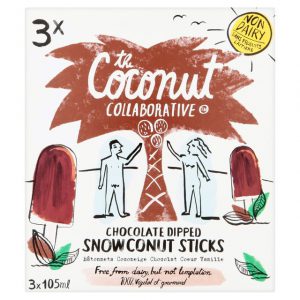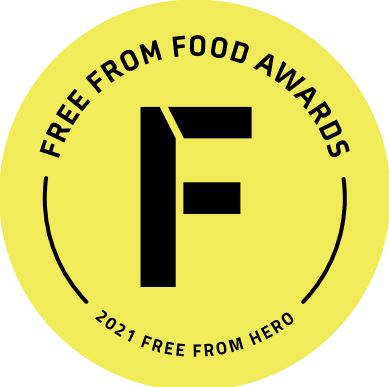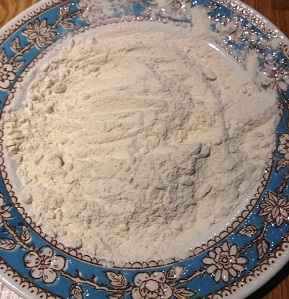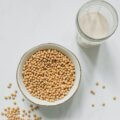If you are allergic to soya you should take a very hard look at anything containing guar gum. This is something I’ve never come across from any doctor or allergy specialist so I’ve never worried about it before. However, if you examine ingredient lists from many freefrom foods, guar gum is often present.
So what does it do and what is guar gum?
Guar gum, also called guaran, is a galactomannan. It is primarily the ground endosperm of guar beans. The guar seeds are dehusked, milled and screened to obtain the guar gum.[1] It is typically produced as a free-flowing, off-white powder. (Wiki)
It increases yield in baked goods and also helps thicken dairy products but it’s uses are not just limited to food, though typically they are most widely used in gluten free goods. Guar gum is also used in the paper, explosives, pharmaceutical and cosmetics industries, to name just a few.
Why on earth are we eating this stuff?
But I’ll get to the point. The point that guar gum can contain traces of soya protein.
The Super Healthy Children website says, “Because guar gum may contain traces of soy proteins, eating it can lead to an allergic reaction. Symptoms may include vomiting, nausea, diarrhoea, cramping, runny nose, nasal congestion, shortness of breath, wheezing, coughing, chest tightness, hives or skin rashes. A severe and possibly life-threatening reaction of anaphylaxis could occur in rare cases with the consumption of soy proteins.”
Well… I’m speechless.
I’ve been having random and unexplainable, albeit mild but still worrying allergic reactions now so could guar gum be the culprit? It still might not be the guar gum but I’m suspicious and Mr What Allergy discovered this link whilst googling the problem.
I was eating a Coconut Collaborative Dark Chocolate Snowconut Stick and my throat began to itch and tingle. It didn’t progress from there but if you have ever had anaphylaxis, this is where it begins. I felt a very slight shortness of breath and the sypmtoms lasted for quite some time. So we checked the ingredients. Nothing in there that I was worried about…
Ingredients: Coconut Cream (32%), Water, Grape Juice Concentrate, Chocolate (17.2%) (Cocoa Mass, Coconut Sugar, Cocoa Butter), Inulin (from Chicory), Natural Flavour (1%), Vegetable Emulsifier: Mono & Diglycerides of Fatty Acids, Stabiliser: Guar Gum, Locust Bean Gum, Vanilla Pod (1%)

I had ignored the ‘may contain soya’ warning, thinking it was probably from the chocolate and soya lecithin which is not such a problem for those allergic to soya. But no… it would seem it was a very valid warning.
I have eaten their yogurts no problem and if you look at the ingredients for them they contain corn flour instead of guar gum. So just consider, because one product from a company is OK doesn’t mean they all will be.
Mr What Allergy has kindly and happily eaten the other two, proclaiming them to be just as good as any ‘normal’ ice cream on a stick. He is somewhat of a connoisseur in this field so this is high praise.
And since I am now on a mission to ‘cut out processed food’, he has helped me by removing any temptation to try another one.
So watch out for anything with guar gum if you have a soya allergy and also heed warnings on packs.
Has anyone else experience a reaction from guar gum? or from these choc ices? Where does the risk of soya come from in this product. I have sent an email to the people at Coconut Collaboratives to find out.












I’ve not tried these – specifically because although the packet may make no mention of it, they produce their products on the same equipment as products containing cow’s milk. When their yogurts first came out, me and my daughter both experienced reactions and since then I have learned that we are not alone in this regard. Therefore I would query whether in fact you had a reaction to a hidden trace of dairy.
Hmmmm… so the fact it says ‘freefrom dairy’ may not actually be the case? I’m very disappointed. I’m waiting for them to respond. I have had the yogurt and not had a reaction so I guess it’s a case of Russian roulette as to which batch and how close it came to the dairy traces on the machine.
On a separate note, the website which mentions use of soya/guar gum together is from the US. I’m not sure that would be allowed in the UK – especially with the current EU regs. The US seem much more lax about these things. Alex Gazzola might know more.
Thanks for this… I will ask Alex. And yes they are far more lax in the US. It is certainly not something I have ever come across before.
Belatedly hearing my name being called ….
The thing that jumps out at me is that guar is a legume – like soya, chickpea, peanut – so there’s potential for cross-reactivity.
Just a possibility …
Alex
I’m not sure whether it’s that or possible dairy cross contamination. This is what they told me:
No other dairy ice creams are currently produced on the same production line although the factory where the products are made does handle other dairy products.
So far all the results for milk protein have come back saying <2.5mg/kg, which is the lowest level achievable. In the long term we're going to have our own production line which will enable us to eliminate any traces of dairy whatsoever, however as we're still a start-up this hasn't been possible quite yet!
So I wonder if it's either the manufacturing process or the chocolate they use as I react to some chocolate that swears it's nut and dairy free. Who knows. But I do have a quite a severe dairy allergy so maybe 2.5mg per kg is too much for my body.
This is what Coconut Collaboratives told me: Thanks for getting in touch. We’re very sorry you had a bad reaction after eating one of our Choc Dipped Snowconut sticks.
The risk of soya traces comes from the chocolate coating we use as the chocolate is also made in a factory which handles soya.
We also make a range of mini milk style sticks called ‘Little Coconutters’- these are Vanilla Snowconut sticks without the chocolate coating which may be more suitable for you if you have a soya allergy. You can find these in Co-op stores as well as online on Ocado.
Please do send us your address so we can get a refund sent out to you so you can give our Little Coconutters a try instead.
Best Wishes,
Zoe & The Coconut Collaborative team
PS. I have now asked them for more information on whether dairy products are made on the same line. This really worries me… if they are, the a product can label itself free from dairy WITHOUT a may contain dairy warning. Yet is does have a soya may contain warning.
I’m catching up on your blog and noticed this post particularly.
Could it be that the problem was ‘ the Vegetable Emulsifier: Mono & Diglycerides of Fatty Acids’? I have avoided them after someone said that they can be derived from soya when I had a reaction to a product including them.
Here’s something that came up when I googled it today: E471
Mono- and diglycerides of fatty acids (glyceryl monostearate, glyceryl distearate)
A normal part of digestion, prepared commercially from glycerin (see E422) and fatty acids. These are normally obtained from hydrogenated soya bean oil so may be GM.
I don’t have anaphylactic allergies but delayed. Even at that, it definitely helps when I avoid these, but they are in almost everything. I think the theory is that the emulsifier is so refined that none of the soy remains.
Yes and it’s the same with soya lecithin, but I would argue that a bit does remain. It’s not enough to give me the strong anaphylactic reactions that soya milk and protein give me but if I eat lots of foods with soya derived and soya lecithin I do begin to just have mild itching, hives, nodular Prurigo. So I have put myself on a pretty much processed food free diet. It’s tough to stick to sometimes but it’s really helped my allergy and eczema reactions. So you are right in limiting your intake. Since with these things you don’t get told where they derive from it’s the safest option.
This is an older post but I still think it’s worth commenting on. I’m allergic to soy and peanuts but even after eliminating these foods—and chances of cross contamination—I continued to have symptoms. I paid even more attention to what I was eating and noticed symptoms with hummus, lentils and foods containing guar gum (this was a long process). I finally realized ALL legumes caused problems for me including rooibos tea, mesquite, tamarind (in Worchester sauce), locust bean gum, etc. Once I eliminated all legumes my symptoms went away. I read that being allergic to one legume increases the likelihood of being allergic to others.
Crikey… all of them? Well it makes sense. I have problems with soya, peanuts, kidney beans and broad beans… but weirdly I can tolerate chickpeas, lentils, etc. and peas are ok. Out bodies are all so fascinating. Well done on working out your triggers.
My daughter had an allergic reaction to soy on Monday to homemade beef chow mein. Then an allergic reaction to locust bean gum on Tuesday from eating a Hartley’s jelly pot. Then an allergic reaction to guar gum on Wednesday from eating a Ms Molly’s raspberry ripple mousse. Then on Thursday she had an allergic reaction to soy lecithin from eating a Mars bar.
I assumed that locust bean/guar gum were not associated with soybean, but they are products from processing other legumes. There is a protein in guar gum that is also in locust bean with ratios 1:2 and 1:4 respectively. I was informed that soy lecithin contains so little soy protein that most can continue to eat products without an allergic response occurring, which leads me to wonder whether the carob/guar has increased her allergic response? As she has previously eaten soy lecithin products without issue.
Learning the hard way this week!
The legume link is real! Thanks so much for sharing this comment. So sorry I never replied sooner.
My son has a peanut/nut and leagum allergy (to all beans). He was having a bad reaction to instant Oatmeal. I couldn’t understand why. We thought he was allgeric to Oats. But I’ve recently discovered and read up on guar gum.
Well what do you know guar gum is a leagum. If you are allgeric to leagums avoid guar gum at all costs.
Keep learning and educating yourselves.
Knowledge is power in beating food allgeries.
It would seem there could be a cross reaction or link to other legume allergies. So glad you got the bottom of that one.
I just, this week, had a reaction to an ingredient that has Ceratonia Siliqua Gum, an ointment, it gave me the same severe migraine that soy products give me. I was as sick as if I had had soy, and or vanilla beam which I am also discovered lately I am also allergic too, the Carob tree where the Locust bean gum comes from , another type of bean which looks like vanilla bean
It’s so fascinating how these foods have relationships and cause cross reactions. So sorry to hear about your recent reaction but hopefully you are on the road to avoiding future reactions.
Vegetable Emulsifier: Mono & Diglycerides of Fatty Acids Are often soya based. They make SO much from the whole soya plant – much of it labelled genetically as ‘vegetable……’ such as starch, esterised fatty acids and diglycerides. I have a huge long list of E numbers and additives that I react to. Soya allergic people apparently aren’t allergic to anything not from the soy bean, so those are highlighted on labels. I’m not allergic to soya, but am incredibly intolerant to the things made from bay part of the plant. My theory is that it raises my oestrogen levels and gives me a migraine, upset and painful stomach, hot flushes and a few other symptoms. Proven only by nothing contradictory so far to that theory. Even tablets with microcrystalline cellulose in make me ill. I can be ill for many days and even weeks from accidental ingestion. Luckily it doesn’t seem to affect my asthma or bronchiectasis like hormones used to in my youth though.
Hi Sarah, thanks so much for your comment. This sounds so complicated, what a nightmare. I am mostly allergic to soya milk the worst, and any product made from it, but for some reason the flour isn’t as a bad and soya lecithin is fine. Make that make sense. I think there must be much less protein, if any left in the lecithin. I try to avoid all those nasty things too as I get skin and stomach reactions but no idea which additive or thing is doing it. Free from processed foods do not agree with me! Soya for me is a massive asthma attack. So interesting how all our reactions are different and so complicated. Thanks again for your comment. and I hope you stay safe and don’t get caught out.